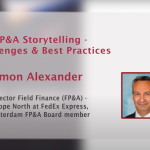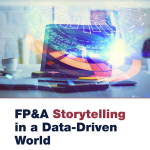Data storytelling tools like dashboards have been around for a long time, but they have recently...
FP&A Storytelling has been one of the biggest trends in FP&A over the last few years as executives and C-level leaders want to know how their company is performing, what segments are performing well or not so well, and why so.
It is the art of using financial and other data to tell a story that resonates with stakeholders. It helps in presenting the company's financial performance in the form of a story that gets the point across in a memorable way and helps influence the desired action. It integrates the power of storytelling and reporting. A story is more than a spreadsheet or a presentation and as FP&A professionals we must present a story in a compelling way that influences the desired action.
“The key to using analytics is extracting insights that drive effective decision making and storytelling works as a lever to get the most out of those insights” - John Sanchez, FP&A Trends Author
“To find signals in data, we must learn to reduce the noise - not just the noise that resides in the data, but also the noise that resides in us” - Stephen Few, Author, Thought leader.
At the Digital FP&A Board, senior finance professionals from diverse backgrounds and experiences shared their views on the subject of FP&A Storytelling. The panel of experts included:
Olga Rudakova, Finance Professional and Data Skills trainer.
Tanbir Jasimuddin, Director of Finance at Vardags,
Veronica Lopez, Director of Finance, Customer Development at Nestle Canada
Michael Lengenfelder, Head of FP&A Product Management at Unit4
How to Do FP&A Storytelling?
At the webinar, Olga Rudakova, finance professional and data skills trainer, walked us through how to do FP&A Storytelling.
We need to use stories to help our audience understand financial insights, connect with them emotionally and make data-driven decisions. Data visualisation can be used to tell any story in an effective way by organising data in a visually appealing and easy-to-understand way.
The below image shows 2 charts. The chart on the right is telling the same business story as the one on the left. However, the chart on the right is much more effective as it gives a clear narrative and a recommendation. There is always a story in our financial data and it's our job as FP&A professionals to find it.
Figure 1
At the webinar, we also conducted a quick poll to ascertain how the participants' companies are spending the majority of their time.
More than half of the participants responded that they are still spending the majority of their time on data reconciliation and reporting. About 35% are spending the majority of time on analysing and interpreting data, while only 9% spend most of their time on storytelling and business partnering.
Figure 2
The Building Blocks of FP&A Storytelling
Tanbir Jasimuddin spoke during the next part of the webinar. The Director of Finance at Vardags shared the following insights from his experience:
There are 3 key building blocks of FP&A Storytelling:
The Narrative - Knowing your business and the decision thought process is critical to drafting any story.
The Visuals - Leverage the power of data visualisation can help uncover insights that could have otherwise been missed.
The Data - It is the foundation on which FP&A storytellers build their narratives.
Figure 3
Next, we asked our participants “Which of the following statements is the best description of your current reports/dashboards?”.
More than half of the participants responded that they have developed some level of consistency. About 22% responded that they adhere to a corporate design. While 18% feel that there is no consistency in their reporting.
Value Creation Through Storytelling
Veronica Lopez spoke during the next part of the webinar. The Director of Finance, Customer Development at Nestle Canada shared the following insights from her experience:
We tell stories to entertain, to sell, to educate and to share financial insights. Many people are faced with the decision of using PowerPoint presentations to show their financial insights. When you can choose between PowerPoint presentation and storytelling, there are plenty of benefits to using both.
Figure 4
Understanding some of the universal plots (common plots that exist in every story) can be useful. Here are some examples:
Overcoming the monster (David and Goliath; Tesla)
The Quest (The lords of the rings, Twitter)
Rags to Riches (Wolf of Wall Street ; startups)
Voyage and Return (Back to the future; Apple)
Comedy (Airplane; Paypal)
Tragedy (Hamilton; Kodak)
Rebirth (Groundhog day; Phillip Morris)
Our focus as storytellers should be on our audience, their needs and insights.
It is important to understand your Audience - who are you communicating to?
What are our audience’s most essential Needs?
Insight - what’s the business issue, decision or action that's needed?
In the next poll, we found out that for 33% of the participants, the biggest barrier to effective storytelling is lack of time while 27% voted for inadequate skills and 18% think it's for the poor quality of data.
Importance of technology in leveraging FP&A Visualisation
In the final part of the webinar, we heard from Michael Lengenfelder, head of FP&A Product Management at Unit4. Micheal discussed the role of technology in FP&A Storytelling.
Figure 5
In the above example, we see the 12 months always compared with the current and previous year, and we see the deviations in absolute and relative terms. To the right, we see the commentary part, which is basically the beginning of the storytelling. The users should immediately be able to see the charts, identify where do we have issues (for example: where are we underperforming and where things are going well). They should be able to enter those comments to explain the good and the bad.
A good report should tell stories immediately. It should grab the reader's attention and make them want to continue reading. FP&A professionals are journalists within their company. We should not just provide facts, as journalists we should provide the necessary context along with recommendations. The most successful articles are ones that combine statistics with personal anecdotes.
For the senior management, reporting should feel like reading a newspaper. They should get a condensed picture with visualisations of data, a lot of comments and ideally recommendations on what should be done to reinforce success or to mitigate risks and problem areas.
Conclusions and Recommendations
The key takeaways from the session are:
Knowing your audience and tailoring the stories to your audience’s needs.
To become a good storyteller you should structure facts and numbers into a story and add a bit of emotion. It will not only help your story to be remembered but you will be remembered as well.
Know your business and be curious to understand your value drivers.
You don't need to have all the data reconciled. You can still tell a story focussing on the key data points
Be a journalist for your organisation. Share condensed visualisations of data along with a lot of comments and recommendations.
In conclusion, FP&A stories are the most powerful form of organisational communication. By putting a narrative behind the numbers and telling compelling story finance can influence our stakeholders thinking and motivate them to take the desired action.
We would like to thank our global sponsor Unit4 for great support with this Digital FP&A Board.
Subscribe to
FP&A Trends Digest

We will regularly update you on the latest trends and developments in FP&A. Take the opportunity to have articles written by finance thought leaders delivered directly to your inbox; watch compelling webinars; connect with like-minded professionals; and become a part of our global community.






